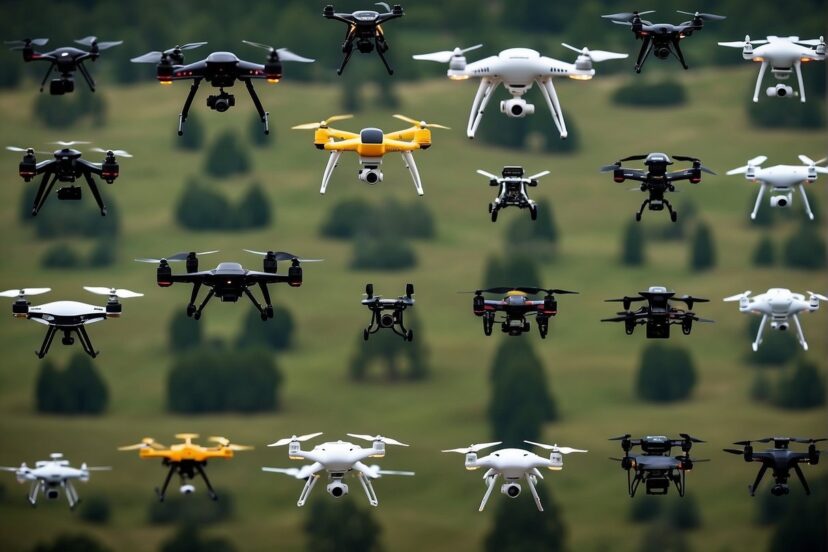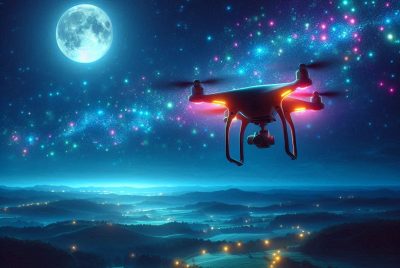Types of Drones: Navigating the Sky’s Diversity
*We may earn a commission for purchases made using our links. Please see our disclosure to learn more.
Types of Drones: Understanding Different Categories and Uses
Drones, also known as unmanned aerial vehicles (UAVs), have surged in popularity and utility across various sectors. My explorations in the field have shown me that these versatile machines come in many forms, each designed for specific purposes and environments. From the compact consumer drones that buzz around parks, capturing stunning 4K videos, to the sophisticated models that military and commercial industries rely on for surveillance and deliveries, the types of drones is expansive.
As I’ve learned, the primary categorization of drones is often based on their design, such as multi-rotor, single-rotor, fixed-wing, and vertical take-off and landing (VTOL) UAVs. Multi-rotor drones, which include the common quadcopters, are favored for their stability and ease of control, making them suitable for beginners and professional photographers alike. Single-rotor drones, resembling miniature helicopters, can carry heavier payloads and offer longer flight times, which is ideal for more demanding tasks like aerial mapping or search and rescue missions.
The technology behind drones continues to evolve, introducing greater levels of autonomy, range, and capabilities. Fixed-wing UAVs, for example, mimic the design of airplanes and can cover larger distances with their gliding motion, an advantage for agricultural monitoring or environmental surveys. VTOL drones, combining elements of helicopters and airplanes, provide the benefit of both maneuvering capabilities and efficient long-range flight, making them a fascinating subject of study for future transportation and logistics solutions.
Types of Drones: Basic Drone Classifications

The scope of drone technology spans various sizes and capabilities, from diminutive nano-drones that fit in the palm of your hand, to large scale models used for professional purposes. Let’s break these categories down to help you better understand the role each type plays in the world of drones.
Micro and Nano Drones
Micro and nano drones are the smallest types of drones, typically lightweight and agile, suitable for indoor flight. Nano drones are generally less than 50 grams in weight, making them incredibly portable. My experience with micro drones indicates that they usually measure under 250 grams, requiring no registration for recreational use in many countries due to their minimal size and weight.
Small Drones
Small drones include models that can weigh up to a couple of kilograms and often range between 20 to 80 inches in length. These drones are commonly foldable, like the DJI Mavic Pro, enhancing their portability. Although small, many are equipped with sophisticated features such as high-resolution cameras and advanced flight modes.
Medium Drones
When it comes to medium drones, I find that these are typically used for more serious endeavors such as professional photography or remote sensing. They’re heavier and larger than small drones, and they may require special handling or regulatory compliance due to their increased size and capabilities.
Large Drones
Large drones are at the top end of the scale, often employed by military and commercial operations for tasks like surveillance or delivery. Their considerable size is paralleled by their capabilities, such as prolonged flight times and hefty payload capacities. These types of drones are not typically available to the general public and require specialized knowledge and permissions to operate.
Types of Drones: Understanding Drone Technology

In exploring drone technology, I’ll dissect the intricacies behind their operation, from the aerodynamic design that allows them to soar to the sophisticated systems that guide them across the skies.
Aircraft Design
Drones, or unmanned aerial vehicles (UAVs), come in various designs, each serving distinct purposes. Multi-rotor drones are one of the most popular designs due to their vertical takeoff and landing capabilities. Their structure typically involves multiple rotors which provide stable lift and maneuverability. Single-rotor drones resemble traditional helicopters, often providing longer flight times due to their larger rotor. Fixed-wing drones rely on a plane-like design, offering extended range and efficiency, ideal for large area mapping or long-duration tasks. Fixed-wing hybrid VTOL drones combine these attributes, enabling vertical takeoff before transitioning to efficient horizontal flight.
Control Mechanisms
The control of a drone is largely dependent on its onboard systems and the user’s input. I operate drones using a hand-held radio transmitter, which communicates with the receiver aboard the craft. Advanced drones often incorporate automated control systems, harnessing GPS and onboard sensors to execute precise flight patterns without constant user input.
| Type of Control | Description |
| Manual Control | Direct operation using a transmitter. |
| Autonomous Control | Pre-determined routes via GPS waypoints. |
| Assisted Control | A combination of user input and automated system assistance. |
Lift and Propulsion
Lift and propulsion are achieved through the rotors and propellers, which work in tandem to provide the necessary thrust. By altering the speed of individual rotors, I can control the drone’s elevation, direction, and stability. The technology behind these systems has to balance power consumption with performance to optimize flight duration and payload capacity.
- Lift: Generated by the aerodynamic forces on the propellers.
- Thrust: Directly linked to the power output and efficiency of the rotors.
Navigation Systems
Drones rely on a mix of technologies to navigate accurately. Most recreational and commercial drones integrate GPS drones technologies, which aid in positioning and route planning. This allows me to set a course using waypoints on a map, with the drone using real-time data to adjust its path as needed. The navigation system also typically includes gyroscopes and accelerometers to maintain stability and orientation during flight.
- GPS: Provides location data for precise navigation.
- Inertial Measurement Units (IMUs): Use a combination of accelerometers and gyroscopes for stability and orientation.
By understanding how these systems and designs interplay, I can appreciate the underlying technology that makes modern drones both versatile and accessible tools for professionals and hobbyists alike.
Types of Drones: Commercial and Consumer Applications

In my examination of the evolving drone landscape, I’ve found that commercial and consumer drones are rapidly transforming various sectors through solutions for delivery, imagery, and agriculture.
Delivery Drones
Delivery drones are an innovative branch of autonomous technology, primarily aiming to revolutionize logistics and package delivery. Amazon’s Prime Air, for instance, is at the forefront, leveraging drones to facilitate faster deliveries. These drones are designed to carry parcels directly to customers’ doorsteps safely and efficiently.
Photography and Videography
Aerial photography and videography have been significantly enhanced by the use of drones, providing remarkable perspectives that were once difficult to capture. Commercial entities employ drones for filmmaking, real estate, and events, benefitting from high-quality, 4K video capability for greater detail and clarity.
Agriculture and Surveying
Drones in agriculture and surveying offer substantial improvements in crop monitoring and land management. For instance, they assist in mapping and surveying vast tracts of farmland to analyze crop health, improve yields and reduce waste. Surveying with drones is more cost-effective and precise, enabling farmers to make informed decisions and manage resources more effectively.
Types of Drones: Drone Performance Factors

When I consider the performance of drones, I focus on their ability to stay airborne, their speed and agility, and their handling of various payloads while maintaining stability. These are crucial aspects that impact their efficiency in different applications.
Flight Time and Range
Flight time refers to how long a drone can stay in the air on a single charge. Most consumer drones have a flight time ranging from 20 to 30 minutes, with advanced models like the DJI Mavic Air 3 boasting up to 46 minutes. The range—how far a drone can fly from its controller—varies greatly, with some capable of flying as far as 7 to 10 kilometers under optimal conditions.
Speed and Maneuverability
A drone’s speed can be critical for tasks such as racing or urgent deliveries. High-performance drones can reach speeds over 40 mph. Maneuverability, on the other hand, is how well a drone can change direction, ascend, or descend. This agility is essential for navigating complex environments and avoiding obstacles.
Payloads and Stability
Finally, payloads refer to the additional weight a drone can carry, such as cameras or sensor equipment. A good drone should be able to carry a significant payload without compromising its stability, which ensures steady footage and reliable operations despite variable weight distributions and windy conditions. Drone stability is often achieved through gyroscopic sensors and flight control systems.
Types of Drones: Military and Tactical Drones

In my examination of military and tactical drones, I focus on their essential roles in modern warfare. These unmanned systems are not only pivotal in gathering intelligence but also in asserting dominance on the battlefield.
Reconnaissance and Surveillance
I understand that reconnaissance and surveillance drones play a crucial part in the modern military’s strategy. The RQ-11 Raven, for instance, is a small hand-launched remote-controlled UAV operated by the U.S. military for over-the-hill surveillance. It’s a prime example of a tactical drone designed for quick deployment and real-time observation.
Military drones in this category significantly expand the reach of surveillance operations. The U.S. Air Force’s MQ-1 Predator and its successor, the MQ-9 Reaper, are larger and more capable drones used in this regard. They carry powerful sensors and cameras that facilitate detailed real-time imagery critical to field operations.
Combat and Tactical Applications
Combat drones, commonly known as Unmanned Combat Aerial Vehicles (UCAVs), have transformative effects on military engagements. They can carry out precision strikes with missiles, eliminating targets while minimizing risks to personnel. The MQ-9 Reaper, for example, is a predator drone that is also equipped for direct combat missions and can be armed with AGM-114 Hellfire missiles.
Tactical drones encompass a broad range of applications beyond reconnaissance and missile strikes. They include target and decoy drones, which simulate enemy aircraft or missiles for training purposes or to deceive enemy defense systems during conflict. These drones provide a realistic yet safe way to train military forces or to test defense systems.
FAQs About Types of Drones
In this section, I’ll address common inquiries about drone types, military classification, and the distinguishing features and functions of various drones.
1. What are the four major types of drones?
The four main types of drones are multi-rotor, single-rotor, fixed-wing, and fixed-wing hybrid VTOL. Each type offers different capabilities, such as vertical takeoff and landing or extended flight duration.
2. How are drones classified in military applications?
In military applications, drones are classified based on their size, range, and endurance. These classifications range from small tactical units to large high-altitude long-endurance (HALE) systems.
3. What distinguishes multi-rotor drones from other drone types?
Multi-rotor drones are distinguished by having multiple rotors, which provide vertical takeoff and landing capabilities, stability, and precise maneuverability, making them ideal for aerial photography and inspection tasks.
4. What types of drones are equipped with cameras?
Many drone types, especially multi-rotors and fixed-wing hybrids, come equipped with cameras. These range from consumer-grade drones for recreational photography to advanced models used in professional film-making and surveillance.
5. How do drones vary in their uses and applications?
Drones vary widely in their uses, from recreational photography to industrial inspection, agriculture, search and rescue missions, and military operations. The design and functionality of each drone type tailor to specific applications.




